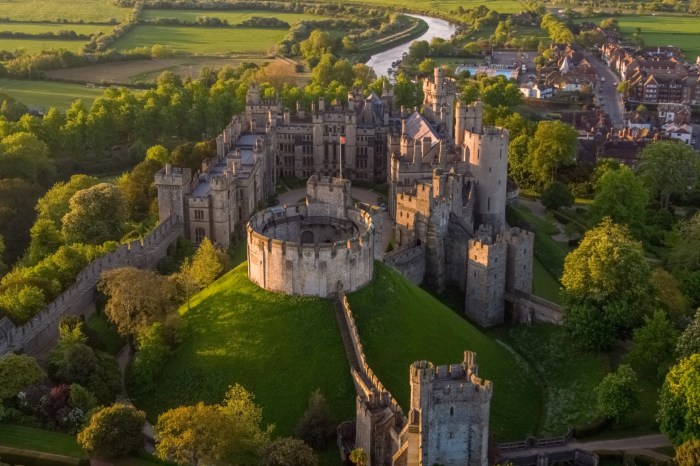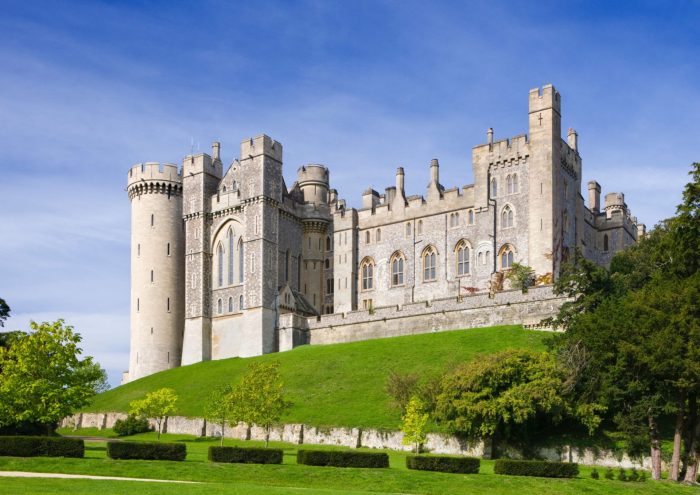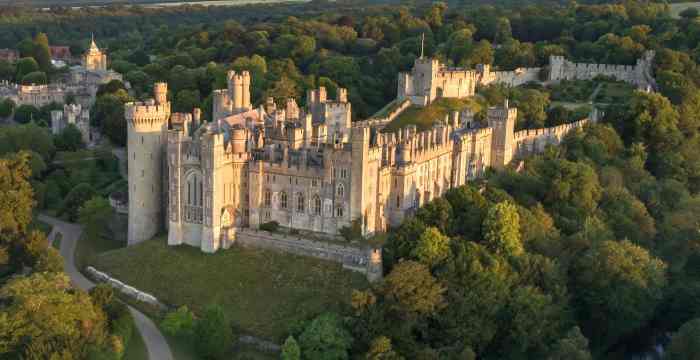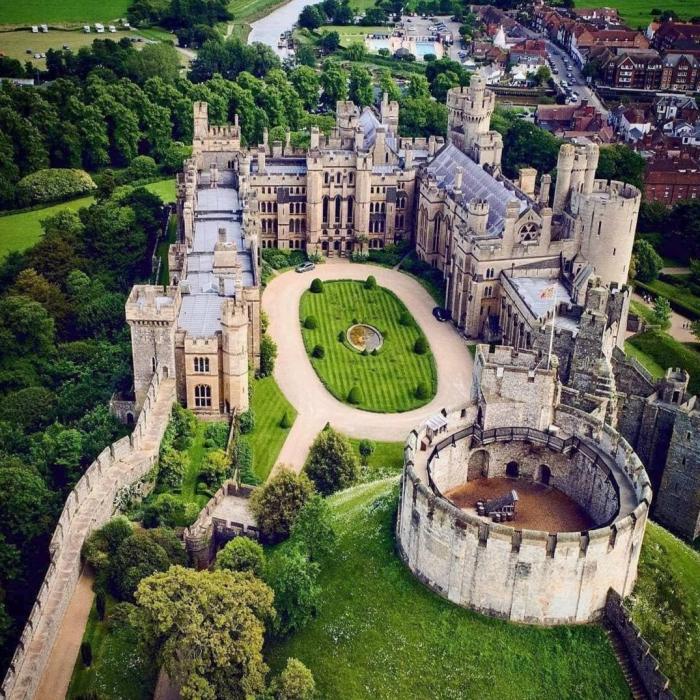Nestled amidst the rolling hills of West Sussex, Arundel Castle stands as a testament to England’s rich history and architectural prowess. With its towering walls, opulent interiors, and sprawling gardens, this magnificent fortress has witnessed centuries of drama, intrigue, and cultural significance.
From its origins as a Saxon stronghold to its transformation into a palatial residence, Arundel Castle has played a pivotal role in shaping the course of English history. Associated with the powerful Dukes of Norfolk, the castle has been a stage for both triumph and tragedy, leaving an enduring legacy that continues to captivate visitors to this day.
Historical Significance
Arundel Castle stands as a testament to the rich tapestry of English history. Its origins date back to the 11th century, when it was first constructed as a motte-and-bailey castle by Roger de Montgomery, Earl of Shrewsbury, in the aftermath of the Norman Conquest.
Throughout the centuries, Arundel Castle has witnessed numerous pivotal events. It played a crucial role in the English Civil War, serving as a stronghold for the Royalist forces. The castle also underwent significant architectural transformations, evolving from a medieval fortress to a magnificent palace.
Association with the Dukes of Norfolk
One of the most notable aspects of Arundel Castle’s history is its close association with the Dukes of Norfolk. The Howard family, who have held the title since the 15th century, have left an indelible mark on the castle’s development.
- The Howards were instrumental in the castle’s architectural transformation during the Tudor period.
- They also played a prominent role in English politics and military campaigns, with several Dukes of Norfolk serving as advisors to the Crown.
- The current Duke of Norfolk, Edward Fitzalan-Howard, continues to reside at Arundel Castle.
Architectural Features

Arundel Castle exhibits a blend of architectural styles that reflect its rich history. Its medieval core, dating back to the 11th century, showcases Norman and Gothic influences, while later additions introduced Renaissance and Victorian elements.
Towers
The castle’s iconic towers, including the Keep and the Barbican, provide strategic vantage points and contribute to its imposing appearance. The Keep, the oldest structure, features thick Norman walls and narrow windows, demonstrating its defensive purpose. The Barbican, added in the 14th century, comprises three semi-circular towers connected by curtain walls, offering a formidable defense against attackers.
Arundel Castle, a magnificent medieval fortress nestled in West Sussex, boasts breathtaking gardens and an awe-inspiring collection of art. Its sprawling grounds include a hidden gem: an arboretum that rivals the renowned arboretum dallas. With over 2,000 species of trees and shrubs, Arundel Castle’s arboretum offers a tranquil escape, where visitors can immerse themselves in the beauty of nature amidst the castle’s rich history.
Walls
Arundel Castle’s curtain walls, constructed from local sandstone and flint, have been reinforced and modified over the centuries. The medieval walls feature arrow loops and crenellations, while later additions incorporate machicolations and gun loops, reflecting the changing nature of warfare.
Gatehouses
The castle’s main entrance is through the 14th-century Barbican Gatehouse, a fortified structure with a drawbridge and portcullis. The 18th-century South Gatehouse, designed by Robert Adam, showcases a more elaborate Palladian style, with its classical columns and pediment.
Building Materials and Techniques
The castle’s construction incorporates a variety of building materials and techniques, including:
- Sandstone and flint: Local materials used in the medieval walls and towers.
- Timber: Used in the construction of roofs and floors.
- Brick: Introduced in the Tudor period and used in later additions.
- Masonry: Skilled craftsmanship evident in the intricate stonework and arches.
Comparison to Other Medieval Castles
| Feature | Arundel Castle | Windsor Castle | Bodiam Castle |
|---|---|---|---|
| Towers | Keep, Barbican, Postern Tower | Round Tower, Curfew Tower | Three round towers |
| Walls | Sandstone and flint, crenellations, machicolations | Stone and brick, crenellations, towers | Brick and stone, double moat |
| Gatehouses | Barbican Gatehouse, South Gatehouse | Henry VIII Gatehouse, Norman Gate | Barbican Gatehouse, Main Gatehouse |
Interior and Furnishings
The interior of Arundel Castle is a testament to its rich history, with rooms and furnishings that have been carefully preserved and restored over the centuries. The castle’s grand halls and opulent chambers offer a glimpse into the lives of the powerful families who have called it home.
State Apartments
The State Apartments, located on the first floor of the castle, were once used to entertain guests and hold official functions. These rooms are adorned with elaborate plasterwork, gilded furniture, and priceless works of art. The Drawing Room, with its panoramic views of the surrounding countryside, was a favorite retreat for Queen Victoria during her visits to the castle.
Private Apartments
The Private Apartments, located on the second floor of the castle, were reserved for the use of the family and their close friends. These rooms are more intimate in scale and feature comfortable furnishings and personal touches. The Duke’s Bedroom, with its four-poster bed and antique furniture, provides a glimpse into the private life of the Duke of Norfolk.
Servants’ Quarters
The Servants’ Quarters, located in the basement of the castle, were home to the large staff that kept the castle running smoothly. These rooms are simple and functional, with basic furnishings and limited natural light. The Kitchen, with its large fireplace and copper pots, is a testament to the hard work and dedication of the castle’s servants.
Floor Plan
The following floor plan highlights the key rooms of Arundel Castle and their functions:
| Floor | Rooms | Functions |
|---|---|---|
| Ground Floor | Great Hall, Library, Dining Room | Official functions, entertaining guests, dining |
| First Floor | State Apartments (Drawing Room, Music Room, Dining Room) | Entertaining guests, holding official functions |
| Second Floor | Private Apartments (Duke’s Bedroom, Duchess’s Bedroom, Children’s Rooms) | Private use of the family and close friends |
| Basement | Servants’ Quarters (Kitchen, Laundry, Storage Rooms) | Home to the castle’s staff |
Gardens and Grounds

The gardens and grounds of Arundel Castle encompass over 40 acres of landscaped parkland, formal gardens, and woodland. The gardens have been carefully designed to complement the castle’s architecture and provide a stunning setting for the historic building.
The formal gardens are located on the south side of the castle and feature a variety of terraces, lawns, and flower beds. The terraces offer panoramic views of the surrounding countryside, while the lawns provide a space for relaxation and recreation. The flower beds are planted with a colorful array of flowers that bloom throughout the year.
Beyond the formal gardens, the parkland extends to the east and west of the castle. The parkland is home to a variety of trees, shrubs, and flowers, as well as a number of sculptures and fountains. The parkland provides a peaceful and tranquil setting for walking, jogging, or simply enjoying the outdoors.
The gardens and grounds of Arundel Castle are a significant part of the castle’s overall design and use. They provide a beautiful and welcoming setting for visitors, and they also play an important role in the castle’s history. The gardens have been used for centuries for a variety of purposes, including entertaining guests, holding weddings, and hosting events.
Layout of the Gardens and Grounds
The gardens and grounds of Arundel Castle are divided into several distinct areas, each with its own unique character. The formal gardens are located on the south side of the castle and are divided into three terraces. The upper terrace is the largest and offers panoramic views of the surrounding countryside. The middle terrace is home to a variety of flower beds and sculptures, while the lower terrace is a more secluded space with a fountain and a small pond.
Beyond the formal gardens, the parkland extends to the east and west of the castle. The parkland is home to a variety of trees, shrubs, and flowers, as well as a number of sculptures and fountains. The parkland provides a peaceful and tranquil setting for walking, jogging, or simply enjoying the outdoors.
Plantings in the Gardens and Grounds
The gardens and grounds of Arundel Castle are home to a wide variety of plants, including trees, shrubs, flowers, and herbs. The formal gardens are planted with a colorful array of flowers that bloom throughout the year. The parkland is home to a variety of trees and shrubs, including oak, beech, and maple trees, as well as rhododendrons, azaleas, and camellias.
The gardens and grounds of Arundel Castle are a significant part of the castle’s overall design and use. They provide a beautiful and welcoming setting for visitors, and they also play an important role in the castle’s history. The gardens have been used for centuries for a variety of purposes, including entertaining guests, holding weddings, and hosting events.
Cultural Impact: Arundel Castle

Arundel Castle holds significant cultural value, inspiring artistic creations and leaving an indelible mark on literature, art, and popular culture. Its majestic presence has captivated the imaginations of countless individuals, making it an enduring symbol of British history and heritage.
In the realm of literature, Arundel Castle has been immortalized in the works of renowned authors. William Shakespeare, in his play “Richard II,” uses the castle as a backdrop for the deposition of the titular king. Other notable literary figures, such as Henry James and H.G. Wells, have also featured the castle in their writings.
Depictions in Art, Arundel castle
Arundel Castle’s architectural splendor has made it a popular subject for artists throughout history. J.M.W. Turner’s renowned painting, “Arundel Castle with Cattle,” captures the castle’s picturesque setting, while John Constable’s “Arundel Castle and Mill” depicts its idyllic surroundings.
Arundel Castle is a beautiful castle located in West Sussex, England. The castle has a long and rich history, dating back to the 11th century. It is one of the most popular tourist attractions in the area. If you are planning a trip to Arundel Castle, be sure to check the abu dhabi time before you go.
The castle is open to the public from 10am to 5pm, but the hours may vary depending on the time of year. Arundel Castle is a great place to visit for all ages. There is something for everyone to enjoy, from the stunning architecture to the beautiful gardens.
Influence on Popular Culture
In recent times, Arundel Castle has gained prominence in popular culture. It has served as a filming location for numerous movies and television shows, including “The Other Boleyn Girl” and “Downton Abbey.” Its distinctive silhouette and historical significance have made it a recognizable landmark, further enhancing its cultural appeal.
Arundel Castle, a magnificent medieval fortress, stands proudly on the River Arun. Its grand halls and opulent gardens offer a glimpse into the past. For a unique travel experience, consider exploring the bustling metropolis of New York City, where airbnb new york offers a wide selection of accommodations.
Upon returning to Arundel Castle, immerse yourself in its rich history and architectural splendor.
Local and Tourism Impact
Arundel Castle has had a profound impact on the local community and tourism industry. As a major tourist attraction, it attracts visitors from around the world, generating significant revenue for the area. The castle also supports local businesses, including shops, restaurants, and hotels.
Moreover, Arundel Castle has fostered a sense of community pride and identity among local residents. Its presence has helped shape the town’s character and contributed to its rich cultural heritage.
Wrap-Up

Arundel Castle is a living testament to the enduring power of history, architecture, and culture. Its grand halls and tranquil gardens offer a glimpse into the lives of those who have walked its corridors, while its stunning architectural features continue to inspire awe and admiration. Whether you are a history buff, an architecture enthusiast, or simply seeking a day of wonder and discovery, Arundel Castle is a destination that will leave an unforgettable impression.
FAQ Insights
When was Arundel Castle built?
The castle’s origins date back to the 11th century, when a wooden fortress was constructed on the site.
Who owns Arundel Castle?
Arundel Castle is owned by the Duke of Norfolk, who is also the Earl Marshal of England.
Is Arundel Castle open to the public?
Yes, the castle is open to the public for guided tours and self-guided exploration.